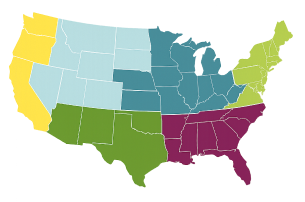
How do we use your location?
Knowing your location helps us recommend plants that will thrive in your climate, based on your Growing Zone.
Blue Cardinal Flower is actually quite different in growth from its wildflower counterpart. It is a tougher, heftier plant with somewhat coarse, larger leaves, and the flowers appear in the leaf axils, unlike its elegant cousins red flowers that are in leaf-free flower spikes, held high above the plant. But the blue flowers are lovely and plentiful. Best of all, this plant is not as picky as to growing conditions. It is perfectly happy in any perennial garden with half sun to part shade. And it is simple to propagate. Let some of the flower heads go to seed in the fall, and you'll have a dozen new plants coming up next spring.
Blue cardinal flower makes a great background for smaller wildflowers, since several together form a wonderful screen-like clump of towering plants with blue flowers for a long period.
Oh, and the name. The botanical species name, syphilitica, comes from the Native American belief that this plant was a cure for syphillis.
As soon as your order is placed you will receive a confirmation email. You will receive a second email the day your order ships telling you how it has been sent. Some perennials are shipped as potted plants, some as perennial roots packed in peat. The ‘Plant Information’ section describes how that item will ship. All perennials and fall-planted bulbs are packaged to withstand shipping and are fully-guaranteed. Please open upon receipt and follow the instructions included.
Perennials and fall-planted bulbs are shipped at the proper planting time for your Growing Zone. Perennial and fall-planted bulb orders will arrive separately from seeds. If your order requires more than one shipment and all items are shipping to the same address, there is no additional shipping charge. See our shipping information page for approximate ship dates and more detailed information. If you have any questions, please call Customer Service at (802) 227-7200 or contact us by email or chat.